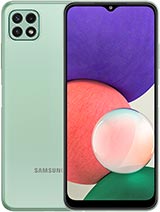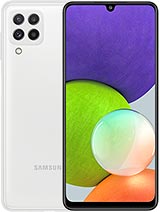The Poco M4 Pro 5G is 2mm taller and 5g heavier than the Poco M3 Pro 5G, measuring 163.6 x 75.8 x 8.8 mm and weighing 195 grammes.
We had a great time with the Poco M4 Pro 5G since it feels robust in the palm and has a good grip owing to the matte frame. It's a big phone, no doubt, but it's in line with the competition and, presumably, what the majority of people want nowadays.
We think the manufacturer did a fantastic job with the design, colour selections, and overall build quality, and we can't think of anything we would alter if we had the authority to.
Display
The Poco M4 Pro 5G comes with a 6.6-inch IPS LCD display with a resolution of 2,400 × 1,080 pixels. It sports a tiny punch-hole for the selfie camera and is scratch and break-resistant thanks to a Gorilla Glass 3 layer. The phone also comes with a thin plastic layer for additional display protection, but we took it off right away because it's so cheap and difficult to clean.

The Poco M4 Pro 5G display has a 240Hz touch sampling rate and a dynamic 90Hz refresh rate. It also supports DCI-P3 colour space. Although the Poco M3 Pro 5G sported a 90Hz screen, it had a slower 180Hz touch sample rate and poorer sRGB coverage.
There is no support for HDR in any way, which we didn't expect.
The screen's estimated normal brightness is 450 nits, according to Xiaomi. We measured 410 nits when manually setting the brightness and 510 nits when using the sunny mode. We were able to capture deep blacks in both situations, resulting in a 1500:1 contrast ratio.
At point white, the least brightness we recorded was only 1.3 nit!
| Display test | 100% brightness |
| Black,cd/m2 | White,cd/m2 | Contrast ratio |
| Poco M4 Pro 5G | 0.264 | 410 | 1553:1 |
| Poco M4 Pro 5G (Max Auto) | 0.33 | 510 | 1545:1 |
| Poco M3 Pro 5G | 0.28 | 413 | 1475:1 |
| Poco M3 Pro 5G (Max Auto) | 0.366 | 536 | 1464:1 |
| Poco M3 | 0.252 | 395 | 1567:1 |
| Poco M3 (Max Auto) | 0.277 | 439 | 1585:1 |
High (90Hz) and Standard (60Hz) refresh rates are available in the MIUI for Poco (60Hz). The High option is described as dynamic, meaning it should automatically transition between 50Hz, 60Hz, and 90Hz based on the material displayed.
When scrolling, the UI should be rendered at 90 frames per second, and when static, it should be drawn at 50 frames per second. The same is true for other static materials in apps that are compatible. In games and streaming/local video playback, 60Hz should be used. Unfortunately, even when a static image is displayed, the inbuilt Refresh Rate metre always indicates 90Hz, thus we can't validate this. The file manager, games, and several video programmes are the sole exceptions (Mi Video, Netflix).
It's worth noting that we can't guarantee that the screen isn't broken. It's possible that MIUI and Android are interacting incorrectly, and the refresh rate metre is displaying incorrect values.
The M4 Pro 5G display now supports DCI-P3 colour space, which is one of the screen upgrades over the Poco M3 Pro 5G. Vivid (default, DCI-P3), Saturated (DCI-P3), and Standard (DCI-P3) are the three contrast levels available in MIUI for Poco (sRGB).
We observed a distinct blue tint in the default Vivid mode, and the colours aren't very true, but vibrant. The Saturated option is the same way. Within the sRGB colour space, the Standard colour is quite accurate, with an average deltaE of 3.
Finally, the Poco M4 Pro 5G comes pre-loaded with Widevine L1 DRM, allowing you to stream video at full HD resolution.
Life of the battery
The Poco M4 Pro 5G has the same 5,000 mAh battery as the Poco M3 Pro 5G. It now supports 33W fast charging, which is an upgrade over the M3 Pro's 18W charging.
The Poco M4 Pro 5G performed admirably in our battery life test, scoring similarly to the Poco M3 Pro 5G. It received the same 123-hour Endurance rating as the
Redmi Note 10 5G and the Poco M3 Pro 5G. It performed admirably in all test scenarios, including calls, online browsing, and video playing, and showed good standby performance.
Our battery tests were automated thanks to SmartViser, using its viSerDevice app. The endurance rating denotes how long the battery charge will last you if you use the device for an hour of telephony, web browsing, and video playback daily. More details can be found here.
 Xiaomi
Xiaomi
Poco M4 Pro 5G
5000 mAh
the rate of charging
Faster charging is one of the biggest improvements over the Poco M3 Pro 5G. The new Poco M4 Pro 5G now enables 33W fast charging and claims to charge to 100% in 30 minutes.
The 33W charger and an appropriate 3A-rated USB cable are included in the retail package, so you won't need to buy anything else to benefit from faster battery charging.
So, we inserted our dead Poco M4 Pro 5G into its original charger, and within half an hour, it had recharged 54 per cent of the battery.
30min charging test (from 0%)
Higher is better
- Realme 7 Pro94%
- Xiaomi Mi 10T Lite 5G68%
- Realme 7 5G57%
- Poco M4 Pro 5G54%
- Xiaomi Redmi Note 10 Pro50%
- Poco M3 Pro 5G33%
- Realme 8 5G29%
- Xiaomi Redmi 1026%
- Samsung Galaxy A22 5G23%
Poco advertises a full charge in 59 minutes. We got ours in 67 minutes, which is in the ballpark. The battery charging is often affected by ambient and battery temperatures, as well as network connection and background services such as automatic app updates. Still, 67 minutes is a great result for a budget device!
Time to full charge (from 0%)
Lower is better
- Realme 7 Pro0:37h
- Xiaomi Mi 10T Lite 5G0:58h
- Realme 7 5G1:06h
- Poco M4 Pro 5G1:07h
- Xiaomi Redmi Note 10 Pro1:21h
- Poco M3 Pro 5G2:00h
- Xiaomi Redmi 102:13h
- Realme 8 5G2:20h
- Samsung Galaxy A22 5G2:29h
Reverse wired charging does not appear to be supported by the Poco M4 Pro 5G.
Speakers
The Poco M4 Pro 5G includes two stand-alone speakers on the top and bottom sides, hidden behind two specialised grilles, which is an improvement over the M3 Pro 5G's single speaker. Because music comes from both the front and top grilles, the top stereo speaker also serves as an earpiece.
Top speaker • Bottom speaker
Although the bottom speaker is more powerful than the top one, the output appears to be properly balanced when playing music or film.
On top of Android 11 is MIUI 12.5 with POCO spices.
Out of the box, the Poco M4 Pro 5G runs Android 11 with Poco-spiced MIUI 12.5 on top. The MIUI 12 version has been available for a while, and you can't tell it's based on Android 11 because it skins everything so well. The Poco launcher has a somewhat distinct system look, including icons, which you may customise.
The fingerprint scanner on the side of the screen is used to unlock it. The reader is simple to set up, runs quite quickly, and has excellent accuracy.
Setting the unlock method to 'Press' is recommended since the always-on scanner will frequently try to read your palm and/or additional fingers, eventually disabling the fingerprint unlock until you enter your PIN. There is also a 2D Face Unlock option, although it is significantly less safe than the fingerprint option.
Security options
The home screens are populated with shortcuts, folders, and widgets, as is customary. If enabled, Google's Discover will appear in the leftmost window.
There is no Always-on screen on the Poco M4 Pro 5G, and there are no Super Wallpapers either.
Homescreen
The Poco-find MIUI 12 includes an app drawer, but unlike the Redmi phones, the Poco M4 Pro 5G cannot be disabled. It categorises your apps for you automatically. The first option is All, which includes all apps. Communication, Entertainment, Photography, Tools, News, and Business are the next categories. You can change the names of these categories or turn them off entirely.
App drawer
Notification Center and Control Center are separated in the Notification shade. This is exactly what iPhones do, and you can summon them in the same way - pull down from the left side of the screen to access the Notification Center, and pull down from the right side to access the Control Center.
If you don't like the split design, you may turn off the Control Center, and the shade will return to its original appearance and functionality.
Notification Center • Control Center • Options • The old Notification Shade
The task switcher has remained mostly unchanged. In two columns, it lists all of your latest apps. To use the split-screen shortcut, tap and hold on a card, or just slide it left or right to shut it.
Split-screen is possible on the Poco M4 Pro 5G, although it does not allow Floating Window, at least not via the Task Switcher. Some system programmes, such as the Calculator, can be shrunk into a floating window, but only from within the app.
Task Switcher • Split screen • Split screen • Pop-up window
Themes are an important aspect of MIUI, and they're still accessible in MIUI 12. Themes may modify backgrounds, ringtones, system icons, and even the always-on display style, and you can download new ones from the Themes store.
Themes
Xiaomi has added a few of new privacy features to MIUI 12. When sharing content like as images and videos, you may now choose to delete location information and/or other metadata (including device information) to further safeguard your privacy. Neat.
Gallery • Privacy Settings
A Security app is also available in MIUI. It can analyse your phone for viruses, manage your blacklist, control or restrict data consumption, set battery behaviour, and clear up RAM. It may also control the rights of your installed apps, allowing you to set the battery behaviour of certain programmes and impose limits solely on those apps.
MIUI 12 has a gallery, music player, and video player that are all exclusive to MIUI. In certain locations, paid streaming alternatives may be available in the music and movie applications. There's also a Mi Remote for the IR blaster, as well as an FM radio app.
Security • Security • Music • Video • Mi Remote • FM radio
Dark Mode is also supported in MIUI 12, and you may impose it on wallpapers or restrict its use to incompatible applications.
Dark Mode
MIUI 12 is designed specifically for HRR screens and looks fantastic on the Poco M4 Pro 5G. Everything runs smoothly and quickly; the animations are subtle yet effective, and the attention to detail is superb. Working with MIUI on the Poco M4 Pro 5G's 90Hz screen was a blast.
Ads in default apps are a well-known feature of several MIUI ROMs.
How to disable ads
The international ROM version of the Poco M4 Pro 5G has built-in "recommendations" or advertising, although nothing is displayed through the UI even if they were enabled by default. Still, if your phone does display advertisements, you can turn them off, even if it's a pain to do so. For example, if the app scanner's advertising irritates you, simply go to the settings gear and deactivate suggestions. It should be possible to disable ads in the File Manager by going to Settings->About. Disable Recommendations in the Themes section of Settings. Sure, it's not ideal, but at the very least you'll be able to get rid of them all.
Benchmarks and performance
The Density 810 is one of MediaTek's most basic 5G processors, and it's used in the Poco M4 Pro 5G. It's a redesigned Dimensity 700 (found in the Poco M3 Pro 5G), with more CPU cores and more efficient 6nm production methods (vs. 7nm for Density 700).
The Density 810 5G chip features an octa-core CPU with two 2.4GHz Cortex-A76 processors and six 2.0GHz Cortex-A55 processors. The clock speed of the large A76 cores has been raised from 2.2GHz to 2.4GHz.
The GPU is still a Mali-G57 MC2, however, the clock speed has been reduced from 950MHz to 850MHz. Strange, to say the least.
An upgraded 5G modem and ISP are included in the chip.
Finally, the Poco M4Pro 5G comes in two different configurations, both of which have LPDDR4X RAM and UFS 2.2 storage: 4GB RAM + 64GB and 6GB RAM + 128GB.

The M4 Pro's CPU benchmark ratings are excellent, and it provides more than acceptable performance.
We were unable to conduct benchmarks on the Poco M3 Pro 5G and its Dimensity 700, but the Realme 8 5G, which has the same SoC, may be used as a reference.
GeekBench 5 (multi-core)
Higher is better
- Poco M4 Pro 5G1797
- Realme 7 5G1794
- Realme 8 5G1784
- Xiaomi Redmi Note 10 Pro1780
- Samsung Galaxy A22 5G1719
- Samsung Galaxy A32 5G1673
- Xiaomi Redmi Note 101599
- Poco M31398
- Samsung Galaxy A321277
GeekBench 5 (single-core)
Higher is better
- Realme 7 5G598
- Poco M4 Pro 5G597
- Realme 8 5G569
- Xiaomi Redmi Note 10 Pro569
- Samsung Galaxy A22 5G560
- Xiaomi Redmi Note 10534
- Samsung Galaxy A32 5G505
- Samsung Galaxy A32361
- Poco M3308
Even if the GPU frequency is theoretically slower, the GPU scores are still sufficient for the class and comparable to the Density 700 in the Realme 8 5G. However, we had hoped for a little update.
GFX Manhattan ES 3.1 (onscreen)
Higher is better
- Realme 7 5G31
- Poco M4 Pro 5G23
- Realme 8 5G22
- Samsung Galaxy A22 5G21
- Xiaomi Redmi Note 1015
- Samsung Galaxy A3213
- Poco M311
GFX Car Chase ES 3.1 (onscreen)
Higher is better
- Realme 7 5G17
- Xiaomi Redmi Note 10 Pro16
- Poco M4 Pro 5G13
- Realme 8 5G13
- Samsung Galaxy A22 5G12
- Samsung Galaxy A328.1
- Xiaomi Redmi Note 107.9
- Poco M35.9
3DMark Wild Life Vulkan 1.1 (offscreen 1440p)
Higher is better
- Realme 7 5G1589
- Poco M4 Pro 5G1232
- Samsung Galaxy A32 5G1185
- Realme 8 5G1104
- Samsung Galaxy A22 5G1104
- Samsung Galaxy A32686
- Xiaomi Redmi Note 10482
- Poco M3368
Finally, AnTuTu puts the Poco M4 Pro 5G among the top performers in its price bracket.
AnTuTu 8
Higher is better
- Realme 7 5G318535
- Realme 8 5G302059
- Poco M4 Pro 5G296721
- Xiaomi Redmi Note 10 Pro295442
- Samsung Galaxy A22 5G242155
- Samsung Galaxy A32 5G226561
- Xiaomi Redmi Note 10218788
- Poco M3177904
- Samsung Galaxy A32174332
AnTuTu 9
Higher is better
- Realme 8 5G361505
- Poco M4 Pro 5G353663
- Samsung Galaxy A22 5G223188
- Samsung Galaxy A32 5G222125
Finally, we conducted our two stress tests, CPU Throttle and 3D Mark Wild Life, like we normally do.
During one hour of 100% CPU load, the Poco M4 Pro 5G performed admirably in the CPU Throttle test, maintaining 79 per cent of its maximum performance. Then it earned 99.4% stability on the 3D Mark Stress Test, which is a fantastic result.
CPU stress test • GPU stress test
Obviously, the Poco M4 Pro 5G isn't a powerhouse, but it performs admirably when put to the test. The phone never overheats nor throttles. We also didn't notice any uncomfortable hot spots on its body.
Under 90Hz, the UI is fluid, although we noticed latency in some of the busier menus with a lot of programme icons. The same may be said for some of the more difficult games. Sure, no game will be able to attain 90 frames per second; we're talking about perceptible reductions below 30 frames per second. You may, of course, change the game visuals and reduce the resolution if you want to have a smooth gaming experience for a long time.
Yes, the Poco M4 Pro 5G is not a gaming phone, but if you fiddle about with the graphical settings, it can put on a fantastic show. For the most part, it will provide a fluid interface and scrolling experience, which is sufficient for a cheap 5G smartphone.
A standard dual-camera configuration
The Poco M4 Pro 5G has one less camera than the Poco M3 Pro 5G, but it has one more than the Poco M3 Pro 5G. I'm not sure how that's feasible. The new Poco, on the other hand, has a main wide and a secondary ultrawide cam, thus replacing the depth and macro cameras. The M4 is more flexible than the M3 thanks to its ultrawide camera.
The primary camera of the Poco M4 Pro 5G is a Samsung ISOCELL S5KJN1 1/2.76"" sensor with Tetracell filter and 0.64m pixels (same as on Redmi 10 and Realme 8i). PDAF is supported by the sensor, which is paired with an f/1.8 lens. This camera has a Night Mode feature.
A Sony IMX355 sensor with an f/2.2 lens is used in the ultrawide camera. The focal point is set to infinity. The ultrawide cam does not support Night Mode.
A 16MP 1/3.06" OmniVision OV16A1 sensor with 1.0m pixels and a Quad-Bayer filter powers the selfie camera. The sensor is hidden behind a fixed focus lens with an f/2.5 aperture.
The default camera app is characteristic of MIUI in that it allows you to switch between settings by swiping left and right, and it includes all accessible modes except Macro. 0.6x, 1x, and 2x are the three zoom shortcuts. Because the M4 Pro lacks a telephoto camera, the 2x is a digital zoom.
A flash mode switch, an HDR switch, an AI toggle, and a magic wand with beauty effects and filters are all located on the other end of the viewfinder. Behind a hamburger menu, you'll discover more options as well as a shortcut to the settings. You won't discover a way to change the output resolution.
For the primary camera, there is a Pro mode. Manually taking 50MP photos is also a possibility. You may utilise a shutter speed of up to 30 seconds (15 seconds for ultrawide) and an ISO of up to 6400.
Camera app
Photo quality is excellent.
By default, the primary camera saves 12.5MP, which is rather adequate for this price range. The colours are fairly true to life (it's late fall here, so the hues aren't as vibrant), the contrast and dynamic range are excellent, and the noise levels are really low. Auto HDR was turned off, however, even when it was switched on, it refused to fire.
The photographs have moderate quality and are not very crisp; some flora and people's faces may appear to be oil paintings or simply smeared. Still, we're pleased with the Poco M4 Pro 5G photographs at this price range.
The Poco M4 Pro 5G comes with the standard AI trigger. It "improves" your images as normal by saturating colours and increasing contrast based on the subject - sky, vegetation, and buildings.
The 2x zoomed photographs look to have been done more skillfully than a basic crop and upscale. They are crisper and less processed than the normal 1x photographs, and we strongly advocate utilising the 2x zoom if you require a zoomed shot.
Although the zoom is still artificial, clever upscaling is used, which produces somewhat better results than the more common crop and upscale method. These photographs are pretty beautiful if you decrease them to, say, 4MP!



 Main camera 2x zoom, 12.5MP
Main camera 2x zoom, 12.5MP
The 50MP shots are simply upscaled versions of the usual 12.5MP images, therefore utilising the 50MP option is pointless. Not even for improved 2x zoom results, since the viewfinder's 2x digital zoom is sufficient.
The 8MP ultrawide images, especially for a cheap phone like the Poco M4 Pro 5G, are surprisingly appealing. They're well-detailed across the frame, with expertly straightened corners. The noise level is minimal, and the contrast and dynamic range are good for a camera of this type. Overall, these are some of the nicest ultrawide shots we've seen from a low-cost or even mid-range smartphone!
Because the Poco M4 Pro 5G lacks a depth sensor, it must rely on AI to create the depth map needed for portrait mode. And it does a fantastic job of it, with no sudden transitions or chopped bits between the foreground and the background.
The photographs are vibrant and have high contrast; they are clear where it counts, and the blur quality is appealing. Sure, a little more detail would have been nice, but they're still rather good as is. Poco, you did a fantastic job!
For the class, the low-light photographs went out well. They have enough detail, due in part to the noise reduction that isn't overly severe. The colours are vibrant, the contrast is acceptable, but the dynamic range is limited - as is typical in low-light photography.
We recognise that there is potential for development, but keep in mind that this is a cheap phone with a budget camera that performs a good job, which we consider a victory.
We can't advocate utilising Night Mode on the Poco M4 Pro 5G because it's one of the back phones. The Night Mode photographs are frequently noisier, softer, and appear much worse than the default ones. The only advantage we saw was a few restored clipped highlights, which we would never swap for the quality loss.







 Main camera Night Mode, 12.5MP
Main camera Night Mode, 12.5MP
At night, you can see what's on the ultrawide photographs, but closer scrutiny reveals that they're soft and noisy. For what it's worth, they keep nice colours and decent contrast.
The ultrawide camera does not have a Night Mode option.
Here are some photographs shot with the Poco M4 Pro 5G of our typical posters. You can check out how it compares to the competitors. Feel free to look around and compare it to other phones in our large database.
The Quad-Bayer 16MP camera on the Poco M4 Pro 5G saves 16MP photographs instead of the usual 4MP ones. This is the same camera that comes with the considerably more costly Xiaomi 11T Pro, so yay?
Anyway, saving at full quality always results in soft selfies, but we enjoyed the photographs taken with the front camera otherwise. They have pleasing colours and contrast, as well as a strong dynamic range. Sharpness is acceptable, and noise levels are acceptable. We liked what we saw overall, particularly on the phone's screen.
Selfie pictures are also possible, but they are not particularly striking. While the per-pixel quality is generally comparable to that of standard selfies, subject separation is inconsistent, and it may be problematic with more complicated backdrops.
We expect the outcomes to vary dramatically in different locales and with different haircuts, so we recommend giving this mode a shot, but don't hold your breath.
Making a video
With all of its cameras, the Poco M4 Pro 5G allows video capture up to 1080@30fps, and optional electronic stabilisation is available for all snappers in this mode. There is no 4K option, and 60 frames per second is only available on the primary camera (no EIS, though).
The video bitrate is around 20Mbps, while the audio is captured in stereo at a bitrate of 256kbps.
The main camera's 1080p footage is sufficiently detailed, with decent dynamic range, low noise levels, and great contrast and dynamic range. While the footage isn't the finest we've seen, it's adequate for the budget class.
 Xiaomi
Xiaomi




































































































































































2 Comments
if you have any doubts, please let know.if you have any doubts, please let know.
ReplyDeleteRight reviwe
ReplyDeleteif you have any doubts, please let know.